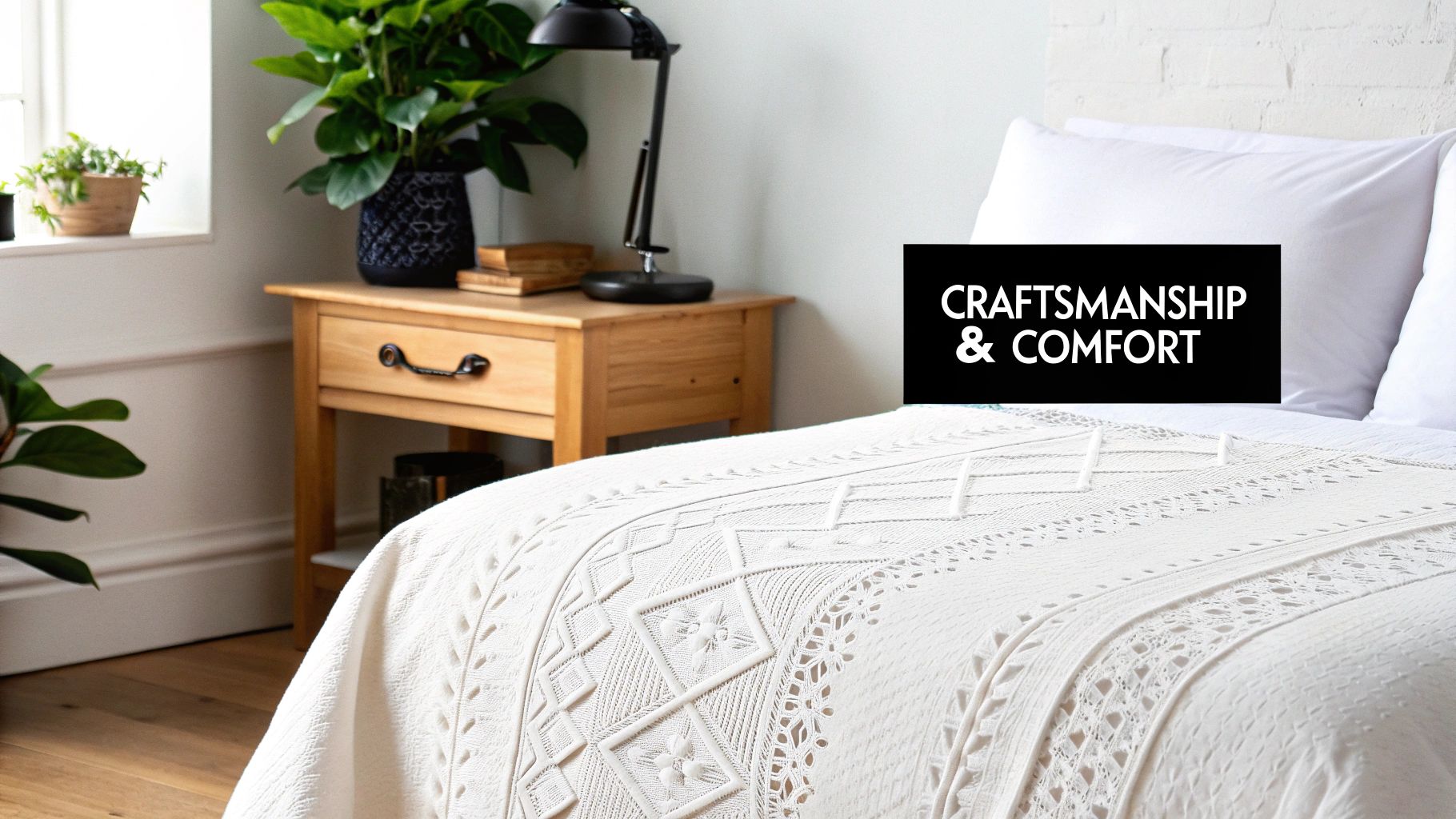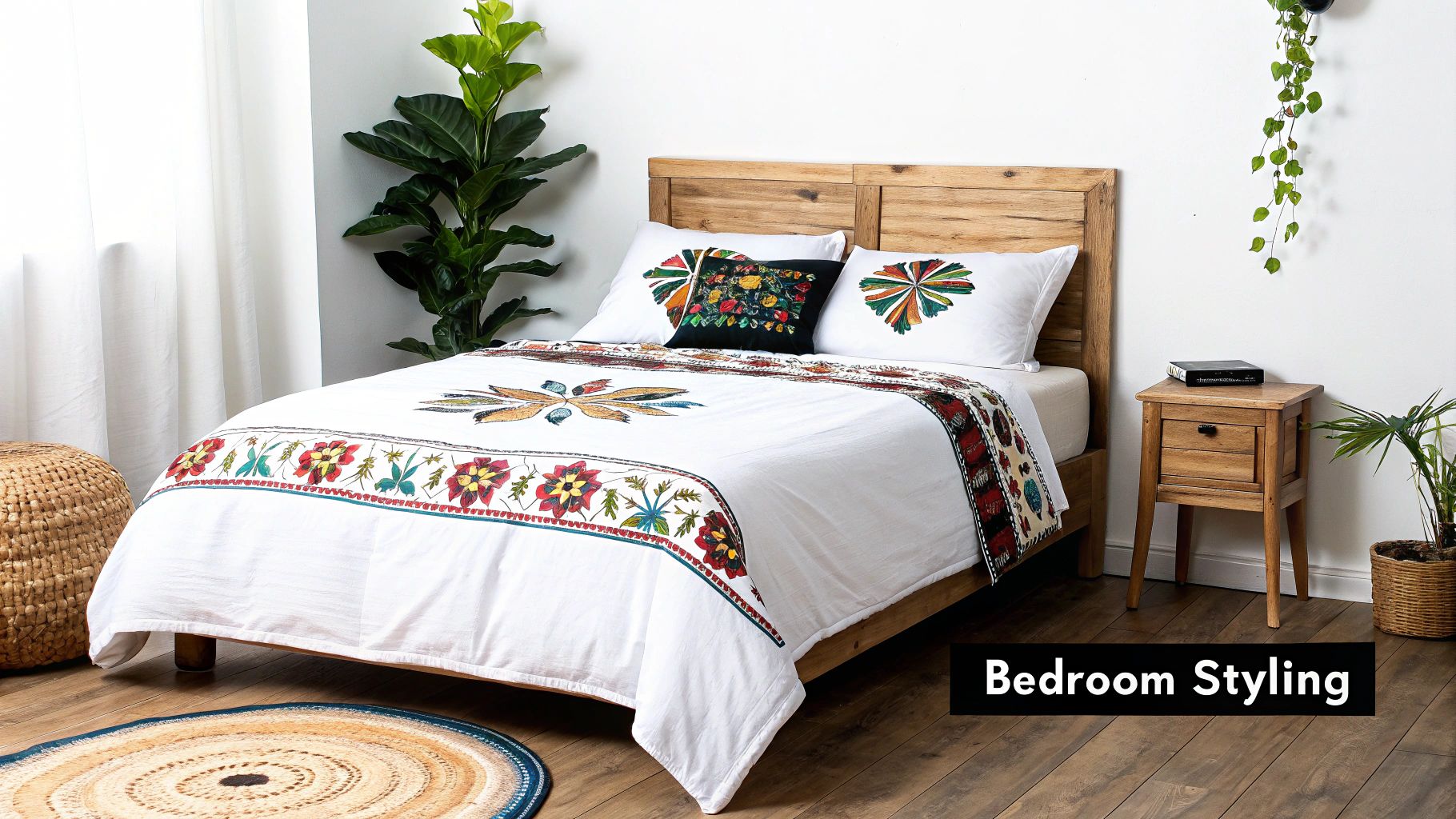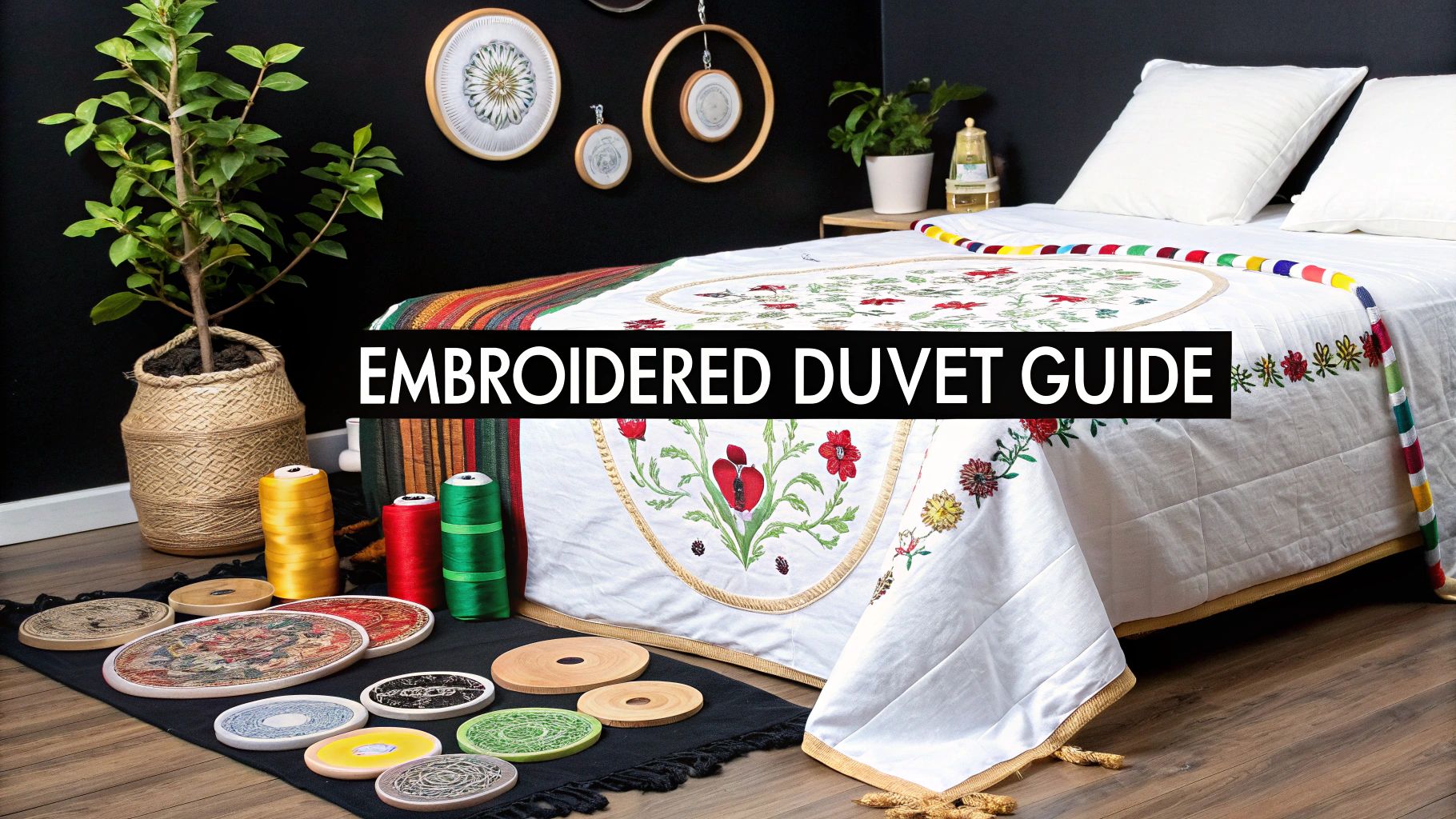Choosing an embroidered duvet cover is not just about picking a pattern. It is about bringing a layer of artistry and texture right into your bedroom. That lovely raised stitching offers a tactile and visual depth that printed designs simply cannot match, turning your bedding from a simple necessity into a beautiful centrepiece.
Why Embroidered Bedding Elevates Your Bedroom

Think of it as the difference between a photograph and a sculpture. A printed duvet is flat, but an embroidered one has a real physical presence. The way the threads catch the light adds a subtle touch of luxury that makes your bed feel far more inviting and thoughtfully styled. If you are new to the concept, you can learn more about what are duvets covers in our complete guide.
This interest in embroidered pieces is more than just a passing phase. Here in the UK, we are seeing a real shift towards appreciating unique and well,crafted home decor. Online searches for "embroidered duvet covers" and "embroidered pillowcases" consistently peak during spring and autumn, which tells us people are actively looking to refresh their bedrooms with more distinctive items.
A Style For Every Home
One of the best things about embroidered duvet covers is just how versatile they are. You can find a design that effortlessly complements the exact look you are hoping to create.
-
For the Minimalist: Imagine a crisp white or soft grey duvet cover with delicate, tone,on,tone threadwork. It introduces just enough texture to avoid feeling stark, creating a serene, five,star hotel feel that is both clean and incredibly comforting.
-
For the Bohemian Spirit: This is where you can have some fun. Look for bold, colourful floral patterns or intricate geometric stitches that really stand out. An embroidered piece like this can easily become the focal point of the room, radiating energy and a free,spirited, handcrafted vibe.
-
For a Classic Look: You simply cannot go wrong with timeless patterns. Think elegant trailing vines, classic monograms, or sophisticated border details. These designs offer a refined finish that never feels dated, lending a quiet touch of heritage charm to your bedroom.
An embroidered duvet cover is an investment in both comfort and style. It brings a sense of craftsmanship into the most personal room of your home, creating a sanctuary that feels uniquely yours.
Finding the Perfect Fabric for You
The feel of your duvet cover against your skin is just as important as the beautiful embroidery. Choosing the right fabric is all about balancing personal comfort with the realities of daily life. It is the secret to creating a bed you genuinely cannot wait to climb into each night.
Your choice of fabric can completely change your sleeping experience. Some of us crave that crisp, cool touch you find in a luxury hotel, while others dream of something silky and smooth. Getting to know the character of each material will help you find the perfect match for your embroidered duvet cover.
Crisp and Cool Cotton Percale
If you love the feeling of slipping into a freshly made hotel bed, cotton percale is your perfect match. It has a distinctive matte finish and a crisp, cool feel that is incredibly breathable. This makes it an absolute winner for anyone who tends to get a bit warm during the night.
Percale is also very durable. It is woven with a simple one,thread,over, one,thread,under technique, which means it gets softer with every wash without losing its strength. That sturdiness provides a fantastic base for embroidery, ensuring the detailed stitching stays secure and looks sharp for years to come.
Silky and Smooth Sateen
For those who lean towards a touch of luxury, sateen is the perfect choice. It has a slightly heavier feel than percale and a beautiful, subtle sheen that feels like silk against the skin. This lustrous surface really makes embroidery threads stand out, enhancing the duvet cover’s elegant look.
Sateen’s unique weave is what gives it that signature drape and soft feel. As a practical bonus, it is also naturally more wrinkle,resistant, which is a lifesaver in a busy household. If you want a bed that feels as luxurious as it looks, sateen is a wonderful way to go.
Think of the fabric as the canvas for your embroidery. A sturdy, high,quality material not only feels better to sleep under but also provides the perfect foundation to support and showcase the intricate threadwork.
Relaxed and Breathable Linen
Linen brings a relaxed, natural aesthetic to the bedroom that is effortlessly stylish. Made from the fibres of the flax plant, it is incredibly breathable and has moisture,wicking properties that keep you cool in the summer and surprisingly warm in the winter. It is a brilliant choice for year,round comfort.
One of linen’s most loved qualities is its unique texture, which only gets softer with time. Yes, it wrinkles easily, but most people see this as part of its charm. It contributes to a laid,back, lived,in look. An embroidered linen duvet cover brings a wonderful sense of rustic elegance to any bedroom.
Choosing the right material is a huge step in finding bedding you will love for a long time. To help you weigh your options, here is a quick comparison of the most popular choices.
Comparing Bedding Materials for Your Duvet Cover
| Material | Feel and Texture | Best For | Care Level |
|---|---|---|---|
| Cotton Percale | Crisp, cool, and matte. Like a high,end hotel sheet. | Hot sleepers and those who love a classic, fresh feel. | Easy to moderate. Can wrinkle, but very durable. |
| Sateen | Silky, smooth, with a subtle sheen. Drapes beautifully. | Anyone seeking a luxurious, soft, and elegant feel. | Easy. Naturally wrinkle,resistant and simple to care for. |
| Linen | Textured, airy, and gets softer with each wash. | Year,round comfort, relaxed aesthetics, and breathability. | Easy to moderate. Embraces a naturally crumpled look. |
Ultimately, the best fabric is the one that feels right to you. For a deeper dive into even more options, we have a helpful guide on the best fabric for a duvet cover. No matter which you choose, the right material ensures your embroidered duvet cover delivers on both comfort and style.
Understanding Embroidery Styles and Techniques
When you choose an embroidered duvet cover, you are not just buying bedding. You are selecting a piece of textile art. The tiny details in the stitching give each design its unique character, and understanding the different techniques can really deepen your appreciation for the craftsmanship involved. It is a bit like knowing the difference between a watercolour and an oil painting, as each method creates a completely distinct feel.
Not all embroidery looks or feels the same because different stitches are used to achieve different effects. Some are bold and smooth, while others are textured and delicate. Getting to know a few of the common styles will make you feel much more confident when picking a design that is perfect for your home.
Common Stitches and Their Styles
The world of embroidery is vast, but you will often find a few key techniques used on high,quality bedding. Each one brings its own personality to the fabric.
-
Satin Stitch: This is the go,to for creating smooth, filled,in shapes. Think of the bold petals on a flower or the surface of a leaf. The threads are laid closely together, creating a seamless, satin,like finish that feels wonderfully sleek to the touch.
-
Chain Stitch: Just as the name suggests, this stitch creates a series of looped threads that look like a chain. It is brilliant for creating outlines and adding a lovely, rope,like texture that gives the design more depth and a slightly rustic, handcrafted feel.
-
French Knot: These tiny, decorative knots are often used to add delicate accents, like the centre of a flower or scattered dots in a pattern. They create a raised, bumpy texture that adds a subtle, intricate detail you can both see and feel.
The technique used in an embroidered duvet cover directly influences its final look and feel. A satin stitch offers a modern, smooth appearance, while a chain stitch provides a more traditional, textured finish.
To truly appreciate the artistry of embroidered duvet covers, or even to consider making your own, a little basic knowledge goes a long way. Exploring a guide on the basic embroidery stitches for beginners is a great place to start.
Hand vs Machine Embroidery
Another important factor is how the embroidery was created. Hand embroidery is a traditional art form where every single stitch is done by a skilled artisan. This method allows for incredible detail and slight variations that make each piece truly one,of,a,kind. It is often found on higher,end, bespoke bedding and carries a real sense of heritage.
On the other hand, machine embroidery is done using computerised machines that stitch patterns with remarkable precision and speed. This technique produces highly durable and uniform designs, making it perfect for creating consistent patterns on a larger scale. It offers a clean, sharp finish that stands up well to regular washing and use.
Speaking of materials, the base fabric is just as important. Knowing about the different types of thread used is also helpful, and you can learn about the best thread count for sheets to understand how it impacts the overall feel.
This infographic outlines the foundational fabric choices that often serve as the canvas for these beautiful embroidery techniques.

Each fabric interacts with the embroidery differently. Cottons provide a crisp, smooth base, while linen offers a more relaxed, textured backdrop that adds to the charm.
Styling Your Bedroom Like a Professional
An embroidered duvet cover is not just bedding. It is the centrepiece of your bedroom, the star of the show. The real secret to making it shine is to build a cohesive look around it. With just a few thoughtful styling choices, you can create a space that feels professionally designed yet uniquely you.

The key is to avoid visual clutter. Think of your duvet cover as the lead actor, while elements like cushions, throws, and curtains are the supporting cast. This approach ensures your room feels harmonious and intentionally designed, not chaotic.
Create a Calming Scandi Retreat
The Scandinavian aesthetic is defined by its clean lines, natural materials, and an overwhelming sense of calm. An embroidered duvet cover fits into this style perfectly when you focus on simplicity and serenity.
-
Choose Subtle Embroidery: Go for a crisp white or soft grey duvet with delicate, tone,on,tone embroidery in white or silver. The stitching adds a lovely tactile warmth without disrupting the minimalist vibe.
-
Bring in Natural Elements: Pair your bedding with a simple wooden bed frame or bedside tables. A few well,placed green plants will breathe life and a touch of organic colour into the space.
-
Layer with Cosy Textures: Finish the look with a chunky knit throw and a couple of plain linen cushions. The goal here is to create a cosy, uncluttered sanctuary you cannot wait to retreat to.
Design a Vibrant Bohemian Haven
If your personal style is more eclectic and free,spirited, an embroidered duvet cover can truly anchor the room. The bohemian look is a celebration of colour, pattern, and an artistic, well,travelled feel.
To pull this off, select a duvet cover with bold, colourful floral embroidery or beautifully intricate geometric patterns. This piece will set the tone for the entire room, so let it be the hero. Layer it with a mix of cushions in different textures, think velvet or macramé, and drape a richly coloured throw over the end of the bed. For even more inspiration, explore our guide to the best bedroom decor ideas.
Your bedding is the foundation of your bedroom’s style. By coordinating your cushions, throws, and curtains with your embroidered duvet cover, you create a thoughtful and inviting atmosphere that looks effortlessly put together.
It is clear that investing in beautiful bedding is on the rise. In fact, the UK's home bedding market is expected to grow by around 6.5% annually until 2035. This growth is fuelled by a strong home improvement culture and a growing desire for sustainable, luxurious products. It shows just how much we value creating comfortable, beautiful spaces at home. You can read more about these UK home bedding market trends to see where the industry is heading.
Achieving a Coordinated Look
Creating a cohesive space does not mean everything has to be a perfect match. It is all about creating a sense of balance and flow.
-
Cushions and Throws: Pull one or two of the subtler colours from the duvet's embroidery and echo them in your accent cushions or a throw blanket. This simple trick ties the whole look together without being too formulaic.
-
Curtains: Your curtains should complement the room's overall colour scheme. A solid colour that picks up on either the base fabric of your duvet or a prominent embroidery thread is always a safe and stylish bet.
-
Headboard and Rugs: An upholstered headboard in a neutral fabric provides a soft, elegant backdrop for your bedding. Likewise, a simple rug placed under the bed can ground the entire arrangement and add another welcome layer of texture.
How to Care for Your Embroidered Bedding
An embroidered duvet cover is a real investment in your bedroom's comfort and style. With the right care, it will stay looking beautiful for years to come. While that intricate stitching might look delicate, you will be surprised at how straightforward it is to look after. It just takes a few good habits to protect the threads and keep the fabric feeling wonderfully soft.
The golden rule is to be gentle. Aggressive wash cycles, high heat, and harsh chemicals are the enemies of both the embroidery and the duvet's fabric. By following a few simple steps, you can easily avoid common problems like snagged threads or faded colours, making sure your bedding remains the stunning centrepiece it was meant to be.
Simple Washing Instructions
When it is time to wash your embroidered bedding, a gentle touch is everything. This is how you protect those delicate threads from getting pulled, snagged, or damaged in the machine.
- Turn It Inside Out: This is the most important step. Before you put it in the wash, always turn the duvet cover inside out. This simple action creates a protective barrier for the embroidery, minimising friction against the machine's drum.
- Use a Gentle Cycle: Always choose a gentle or delicate cycle on your washing machine. Stick to cool or lukewarm water, around 30°C is perfect. Hot water is a no,go, as it can cause the fabric to shrink and the beautiful colours to fade.
- Choose a Mild Detergent: Go for a mild, pH,neutral liquid detergent. Steer clear of bleach and even fabric softeners, as these harsh chemicals can weaken the threads and cause discolouration over time.
Drying and Storing Your Bedding
How you dry your embroidered duvet cover is just as crucial as how you wash it. If you can, always air,dry it. It is the kindest method for the fabric and the embroidery.
If you must use a tumble dryer, make sure you select the lowest possible heat setting. High heat is a recipe for puckering, as it can cause the embroidery threads to shrink at a different rate than the fabric. Once it is completely dry, fold it neatly and store it in a cool, dry place away from direct sunlight.
For more in,depth advice, our comprehensive snuggle comforter care guide has extra tips that work wonders for all fine bedding.
A little extra care goes a long way. Washing your duvet cover inside out on a cool, gentle cycle is the single most effective thing you can do to preserve the beauty of its embroidery.
To really ensure your embroidered duvet cover lasts for a lifetime, it helps to understand the fundamentals of textile care. For a deeper dive into the specifics, you can find excellent guides on how to clean embroidered items. Resources like this offer fantastic insights that will help you maintain the integrity of any stitched piece, keeping it in pristine condition.
What to Check Before You Buy
Choosing an embroidered duvet cover is often the final, exciting touch that brings a whole bedroom design together. But before you fall in love, it is worth thinking through a few practical details. Getting these small things right from the start ensures you will bring home a piece you absolutely adore for years to come.
Think of an embroidered duvet cover as more than just bedding. It is a long,term investment in your home's comfort and style. Taking a moment to check the finer points will guarantee it lives up to your expectations in both quality and everyday use.
Craftsmanship and Quality
One of the biggest factors in the price and feel of an embroidered duvet is whether it is stitched by hand or by machine.
Hand embroidery is a true art form. Each piece is unique, with subtle variations that give it a special character and charm you just cannot replicate. It is a much slower process, which is reflected in a higher price, but what you get in return is a one,of,a,kind heirloom.
On the other hand, machine embroidery offers incredible precision and consistency. The stitching is uniform and robust, making it a brilliant choice for busy households where bedding needs to stand up to frequent washing. Both methods create beautiful results, so the best choice really comes down to your personal priorities and budget.
Think about longevity. A well,crafted embroidered duvet cover, whether made by hand or machine, should be seen as a lasting addition to your home, not just a seasonal trend.
The UK holds a significant place in the global duvet cover market, which is on track to reach $15 billion. Embroidered designs are a growing part of this premium segment, proving that UK shoppers are increasingly willing to invest in high,quality, distinctive bedding. You can learn more about this trend in the European duvet cover market analysis.
Practical Finishing Touches
Finally, do not forget to check the small details that can make a huge difference in day,to,day life.
- Closure Type: Do you prefer the classic, traditional look of buttons, or the quick, sleek convenience of a zip? Zips are a breeze to do up, while buttons can add a lovely decorative touch to the overall design.
- Included Pieces: Does the set come with matching pillowcases? Buying them together is the easiest way to get a perfectly coordinated look, saving you the hassle of trying to match shades and fabrics later on.
- Thread Count: While it is not the only mark of quality, a higher thread count in the base fabric usually means a softer, more durable material. It is a good indicator of how lovely it will feel against your skin night after night.
Frequently Asked Questions
When you are thinking about bringing an embroidered duvet cover into your home, it is normal to have a few questions about how it feels and whether it is practical for everyday life. Let us tackle some of the most common queries so you can feel completely confident in your choice.
Is Embroidered Bedding Comfortable to Sleep Under?
Absolutely. It is a common myth that the embroidery might feel scratchy or rough. In reality, the intricate stitching is almost always on the top side of the duvet cover, the side you see, not the side that touches your skin. The underside is left perfectly smooth for a comfortable night's sleep.
Quality makers use soft, pliable threads that lie flat against the fabric, so you will not feel any bumps or lumps. You truly get the best of both worlds, stunning detail without sacrificing an ounce of comfort.
What if a Thread Gets Snagged?
It happens, but do not panic. A snagged thread is usually a very simple fix. Whatever you do, resist the temptation to grab the scissors and snip it off, as this can cause the embroidery to unravel.
Instead, take a needle and gently poke the loose thread back through to the reverse side of the fabric. Once it is tucked away on the inside, you can tie a small, secure knot to keep it from pulling through again. It is worth remembering that with machine,embroidered designs, the stitching is often so tight and secure that snags are rare in the first place.
Are They Suitable for a Child's Room?
Yes, an embroidered duvet cover can be a wonderful, long,lasting addition to a child’s bedroom. For kids' rooms, it is best to lean towards machine,embroidered options as they are incredibly durable and built to handle a bit more rough and tumble.
Choosing a fun, whimsical pattern can add a touch of magic to their space that feels much more special and textured than a simple printed design. As long as you follow the care instructions, it will stay looking beautiful for years to come.
Ready to find the perfect centrepiece for your bedroom? Explore the beautiful and cosy collection at Morgan and Reid and experience the difference that thoughtful craftsmanship can make. Discover your new favourite bedding.



Share:
Sleep Better with Organic Cotton Bedding Sets
Your Guide to Extra Deep Brushed Cotton Fitted Sheets